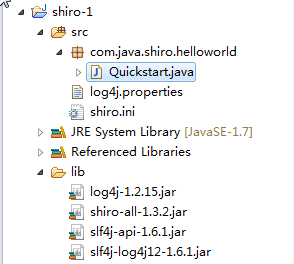HelloWorld
Shiro的HelloWorld不是我们写的,而是看Shiro给我们提供的一段代码。通过这段代码可以看到Shiro大致的使用方式。
1.找到Shiro的jar包
目前的最新稳定版本是1.3.2
需要的4个jar包:
- log4j-1.2.15.jar
- shiro-all-1.3.2.jar
- slf4j-api-1.6.1.jar
- slf4j-log4j12-1.6.1.jar
2.创建一个java工程 ,导入jar包,及从shiro-root-1.3.2-source-release\shiro-root-1.3.2\samples\quickstart\src\main 中拷贝resources下的配置文件及 Quickstart.java

3.对重要的代码做出中文注释
package com.java.shiro.helloworld;import org.apache.shiro.SecurityUtils;import org.apache.shiro.authc.*;import org.apache.shiro.config.IniSecurityManagerFactory;import org.apache.shiro.mgt.SecurityManager;import org.apache.shiro.session.Session;import org.apache.shiro.subject.Subject;import org.apache.shiro.util.Factory;import org.slf4j.Logger;import org.slf4j.LoggerFactory;/** * Simple Quickstart application showing how to use Shiro's API. * * @since 0.9 RC2 */public class Quickstart { private static final transient Logger log = LoggerFactory.getLogger(Quickstart.class); public static void main(String[] args) { // The easiest way to create a Shiro SecurityManager with configured // realms, users, roles and permissions is to use the simple INI config. // We'll do that by using a factory that can ingest a .ini file and // return a SecurityManager instance: // Use the shiro.ini file at the root of the classpath // (file: and url: prefixes load from files and urls respectively): Factory factory = new IniSecurityManagerFactory("classpath:shiro.ini"); SecurityManager securityManager = factory.getInstance(); // for this simple example quickstart, make the SecurityManager // accessible as a JVM singleton. Most applications wouldn't do this // and instead rely on their container configuration or web.xml for // webapps. That is outside the scope of this simple quickstart, so // we'll just do the bare minimum so you can continue to get a feel // for things. SecurityUtils.setSecurityManager(securityManager); // Now that a simple Shiro environment is set up, let's see what you can do: // get the currently executing user: //获取当前的Subject. 调用SecurityUtils.getSubject(); Subject currentUser = SecurityUtils.getSubject(); // Do some stuff with a Session (no need for a web or EJB container!!!) //测试使用Session //获取Session:Subejct#getSession() Session session = currentUser.getSession(); session.setAttribute("someKey", "aValue"); String value = (String) session.getAttribute("someKey"); if (value.equals("aValue")) { log.info("----->Retrieved the correct value! [" + value + "]"); } // let's login the current user so we can check against roles and permissions: //测试当前的用户是否已经被认证,即是否已经登录 调用Subject的isAuthenticated() if (!currentUser.isAuthenticated()) { //把用户名和密码封装为 UsernamePasswordToken 对象 UsernamePasswordToken token = new UsernamePasswordToken("lonestarr", "vespa"); //remeberme token.setRememberMe(true); try { //执行登录 currentUser.login(token); } //若没有指定的账户,则shiro抛出UnknownAccountException catch (UnknownAccountException uae) { log.info("There is no user with username of " + token.getPrincipal()); } //若账户存在,密码不匹配 IncorrectCredentialsException catch (IncorrectCredentialsException ice) { log.info("Password for account " + token.getPrincipal() + " was incorrect!"); } //用户被锁定的异常 catch (LockedAccountException lae) { log.info("The account for username " + token.getPrincipal() + " is locked. " + "Please contact your administrator to unlock it."); } // ... catch more exceptions here (maybe custom ones specific to your application? //所有认证时异常的父类 catch (AuthenticationException ae) { //unexpected condition? error? } } //say who they are: //print their identifying principal (in this case, a username): log.info("User [" + currentUser.getPrincipal() + "] logged in successfully."); //test a role: //测试是否有某一个角色 调用Subject的hasRole() if (currentUser.hasRole("schwartz")) { log.info("May the Schwartz be with you!"); } else { log.info("Hello, mere mortal."); } //test a typed permission (not instance-level) //测试用户是否具备某一个行为 调用Subject的isPermitted() if (currentUser.isPermitted("lightsaber:weild")) { log.info("You may use a lightsaber ring. Use it wisely."); } else { log.info("Sorry, lightsaber rings are for schwartz masters only."); } //a (very powerful) Instance Level permission: //测试用户是否具备某一个行为,比上边那个更具体 :用户user可以对zhangsan进行delete操作 if (currentUser.isPermitted("user:delete:zhangsan")) { log.info("------>You are permitted to 'drive' the winnebago with license plate (id) 'eagle5'. " + "Here are the keys - have fun!"); } else { log.info("Sorry, you aren't allowed to drive the 'eagle5' winnebago!"); } //all done - log out! //执行登出 Subject的logout() currentUser.logout(); System.exit(0); }}
通常在项目中不会使用硬编码的方式,会使用注解的方式来进行配置。

